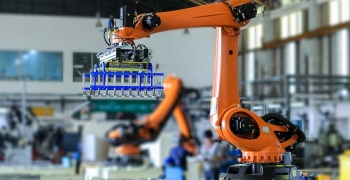Connect the Physical with the Digital

Bridging the divide between the physical and digital worlds, the Industrial Internet of Things (IIoT) transforms how companies function and get work done, based on insights from sensors and microcontroller technologies, connectivity, and analytics. These emerging technologies together define Industrie 4.0.
Businesses focus on operational excellence to streamline and tighten production processes by aligning themselves with the principles of Six Sigma. IIoT gives these companies an opportunity to go beyond Six Sigma, fool-proofing activities and processes to achieve operational efficiency.
These trends reiterate survey findings from this year’s ARC Forum conducted by L&T Technology Services and ARC Advisory Group. Half the respondents were representatives of large corporations having more than $10 billion in revenues. According to the results, 57 percent of business leaders and organizations embrace IIoT for operations-related work. Their focus was to enable augmented operations, human-robot collaboration, advanced digital product development, data-driven control of operations, and predictive maintenance.
Feedback from early adopters, suggests that the transition to an IIoT ecosystem relied on employee initiatives. 42 percent of business leaders felt that organizational culture acted as an impediment to IIoT adoption. Another prevalent concern involved capital expenditure.
While about 40 percent of organizations were found to be at the pilot stage of evaluating IIoT, 31 percent said they were already in discussions with partners and ready to reap the gains from first-mover advantage. Predictive analytics and integrated IIoT are crucial for those adopting IIoT.
Given the Need
Before we delve into the benefits of IIoT, let's take a step back to discuss what really makes up an IIoT architecture. In IIoT systems, industrial assets and operations technology (OT) such as materials, machines, and plant control systems, interconnect with information systems and technology (IT). Users are also connected, along with enterprise business processes and technology (BT). Once connectivity and system data flow between OT, IT, and BT are accomplished, data can be aggregated and analytics applied. The insights thus gained facilitate smart decision-making, which leads to intelligent industrial operations and business models.
While conventional IIoT frameworks are available, a scalable and long-term approach is required to integrate IT, OT, and BT. This will mean IT can deal with increasingly large databases, leaving OT to entrust physical devices and processes, and BT to handle business software applications.
Classifying technologies in this manner can help uncover challenges inherent to the status quo. IIoT technologies can then allow companies to autonomously manage production, integrate customer data with machine data, and harness the power of machine learning. This in turn can drive operational efficiency and innovation, while improving quality, safety, and productivity. Like the remote management systems applied in large-scale computing and telecommunication domains, IIoT enables management of the engineering value chain, from the comfort of a centralized location.
Two typical characteristics of any IIoT-based system are information processing on a 24x7 basis and real-time constraints imposed by the environment.
A comprehensive IIoT architecture constitutes:
- sensors for detecting events or changes;
- edge gateways that aggregate and filter sensor data;
- IIoT Cloud-enabled platforms, including smart-signal aggregators and modeling algorithms;
- Big Data analytics, including machine learning, artificial intelligence, augmented reality, data store, and security.
The entire system is meant to run as a managed service.
Technology firms add value to the IIoT system by offering managed engineering services. Managed services comprise round-the-clock remote monitoring, predictive maintenance using data analytics, and value engineering. These services explain the increasingly popularity of the build-operate-manage model among technology providers.
While business process management and enterprise resource planning integrate systems and processes to an extent, a comprehensive structure enabled by IIoT completes the cycle. An IIoT-enabled framework can integrate processes starting from the product development stage through manufacturing to supply chains. Its capabilities include data-driven inventory, remote asset testing and inspection, data-driven quality control, remote service, additive parts manufacturing, augmented operations, human-robot collaboration, and advanced digital product development.
Some Successes
While IIoT is in the early stages of adoption, inspirational narratives abound. For instance, a global construction company faced critical business challenges managing field assets and equipment. This was addressed using IIoT technologies that enabled the development of a remote asset performance management framework. The framework covers 30,000 assets across 500 asset types. It delivered an estimated 12 percent improvement in asset utilization. On-time asset availability will likely lower overall costs as well.
Services supporting the solution implementation included sensor identification, gateway selection, sensor-gateway commissioning, and on-boarding. Such an IIoT system generates six gigabytes of data per day, deriving data intelligence from about 2,500 nodes.
In another instance, a consumer goods manufacturer addressed the operational disruptions caused by frequent compressor failures in its manufacturing plants using IIoT technologies. The system used predictive analytics to proactively estimate time to failure, leveraging anomaly indicators including temperature, current, and vibration. The model works at more than 70% accuracy and is estimated to result in annual savings of about $500,000.
Anticipated Impact
According to McKinsey, IIoT will have a potential economic impact of $6.2 trillion by 2025. Listed as one of the key technologies capable of economic transformation, IIoT is slated to continue transforming industries at a global scale.
IIoT platforms will be a critical success factor for goods makers and service providers. Industries that leverage IIoT to integrate data, machines, and people will see an impact on productivity, efficiency, and operations. IIoT can be a life preserver in increasingly stormy seas, providing an intelligent technology framework, with benefits for a company, its partners, and customers.




